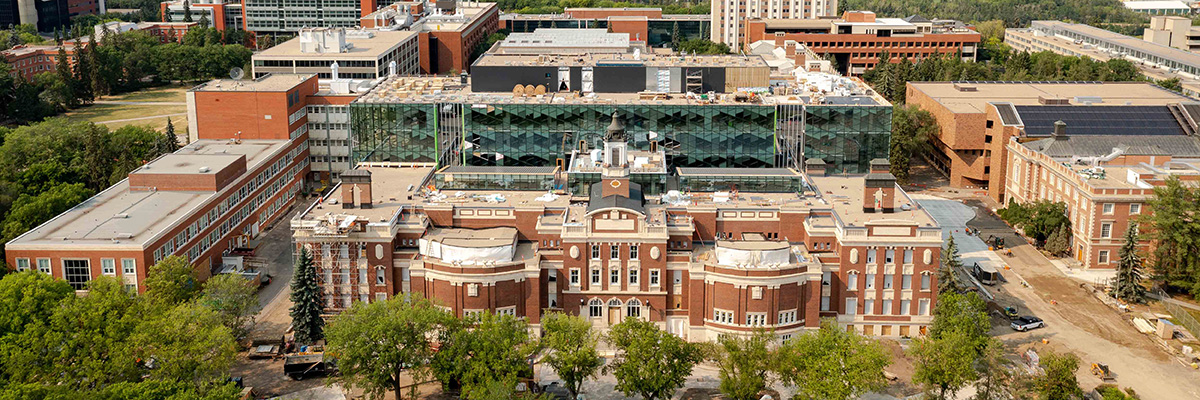The U of A recently held a student space design competition to best support the student experience in the new University Commons building. The winners were selected by key leaders from various areas of the institution, and in this three part series, I (Jeremy) sat down with each winner to learn more about their winning design and why they participated.
The second installment is with Mason, who submitted the winning design for the calming room.

Mason
What are you studying at the university, and what inspired you to participate in the competition?
I am in my fourth year studying Urban and Regional Planning with a minor in Economics.
When I first saw that this competition was taking place, I figured it was too great an opportunity to miss! As I have worked toward my degree in Planning, my interests have leaned more and more toward urban design. At this phase in my program, I had taken all of the available Urban Design classes, and while this competition was more geared toward interior design, it felt like a chance to exercise that creative muscle again.
Since September, I have been participating in a work term at Green Space Alliance, a city planning and urban design firm. In this position, I have had the opportunity to practice design skills by working with tools like AutoCAD, Sketchup and Adobe Suite. This experience has given me the confidence and the applicable skills to take on a project like this.
Above all else, this felt like an opportunity to make a change on campus and have a real positive impact on student life. As this design is implemented, I hope it will be a place that students feel safe and comfortable to gather their thoughts, reflect and recharge.

Mason's winning design. Submissions will influence the final design of the space but may not be identical to what was submitted.
Why did you choose to design the calming room?
I think that students at the U of A are currently lacking a place that is geared solely toward mental health and well-being and that is open to everyone without any expectations. To best serve students on campus, we should not only be providing spaces geared toward learning and productivity but also spaces that acknowledge the emotions and hardships that can come along with higher learning.
In terms of designing the space, I thought that the calming room could also provide greater room for creativity, given that there is not a lot of precedence for this kind of space on campus.
Can you describe some of the key features of your winning design and how they support the purpose of the space?
In designing this space, I tried to tie each element to one of three themes; reflection, connection, or distraction.
The anchor of the design is the window seats that wrap around the exterior of the room. The space benefits from high ceilings, large windows, and plenty of light. Given these factors, the window seats in this room would feel bright and airy. Each window seat is paired with a curtain that can be closed if students desire privacy within the space.
The center of the room is filled with 'family room' style connection spaces which are intended for students to work through their emotions with friends or through UofA services. These spaces are outfitted with comfortable furniture and surrounded by indoor trees and plants, which provide a link to nature and add to the calming effect of the space. Privacy is created through screening offered by the numerous plants and shoulder-height room separators.
Spaces such as a communal workspace, large built-in bookshelves, and an electric piano (with headphones) provide spaces for students to find a distraction while still benefiting from the calming qualities of the room.
One of the key features of the room is the wall dedicated toward being a mural. In my proposal, I suggested that this space be dedicated toward a commissioned mural done by an Indigenous artist. I think an important part of ensuring that this space is inclusive and inviting to all students is through representation. Therefore, this part of the room would help to ensure that Indigenous identity and culture are engrained and honoured in this new building.
What are some of the biggest challenges you faced during the design process, and how did you overcome them?
One of the biggest challenges I had while designing this room was how I could ensure that there was a sense of enclosure. The room is relatively long and has really high ceilings, so I think there was a risk that it would feel too 'wide open' to encourage privacy or comfort.
I was able to tackle this issue by creating an enclosure through the proposed construction and shape of the window seats and through breaking the room down into more manageable sections or 'zones.'
What impacts do you think a space like this will have on students?
My hope for this space is that it will become a place that students can rely on to help ground them and bring some peace to stressful days. It is intended to be a place for students to access independently or with counselling services offered by the University. While I know that the design of this room will not solve any of the issues facing students, it may help them to feel more seen as they navigate their everyday lives.
What are your future aspirations, and how did this experience contribute to your goals?
I am passionate about creating spaces that are usable, sustainable, beautiful, and inclusive. I intend on continuing my studies and working toward this passion through a graduate degree related to either urban design or development. This competition has encouraged me to challenge myself further and to continue asking myself how I can contribute to bettering the built environment around me.

